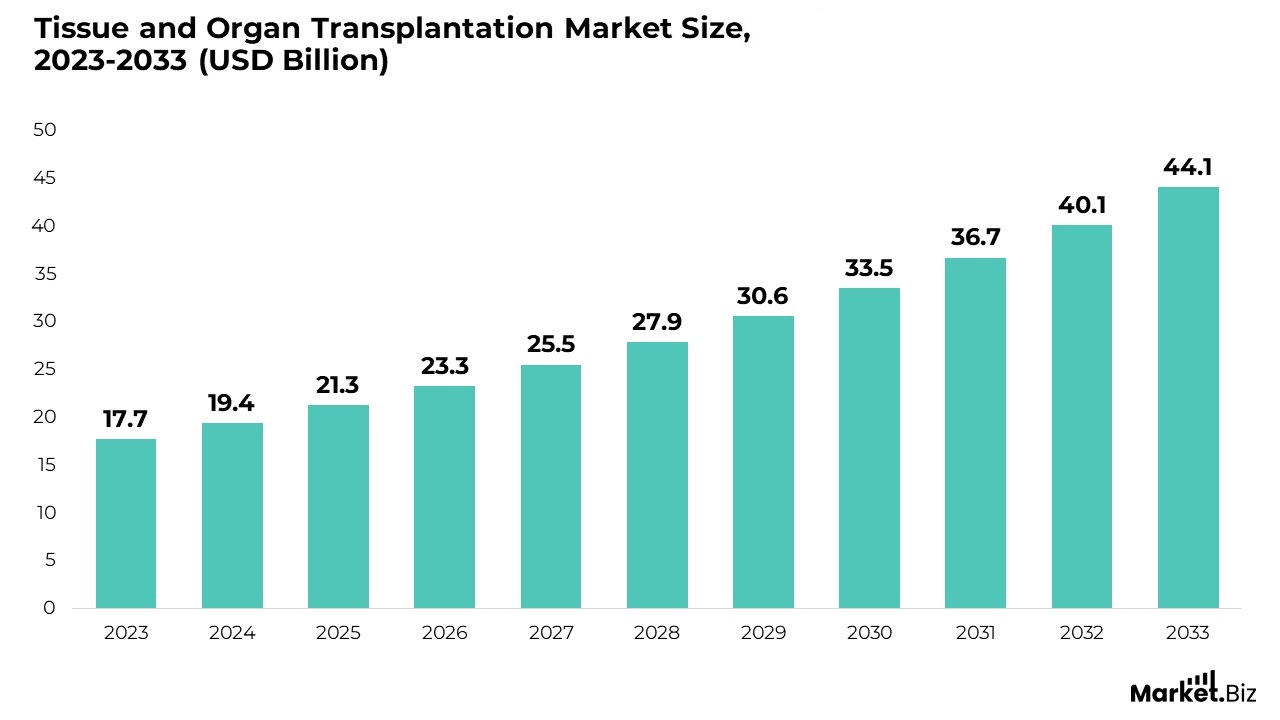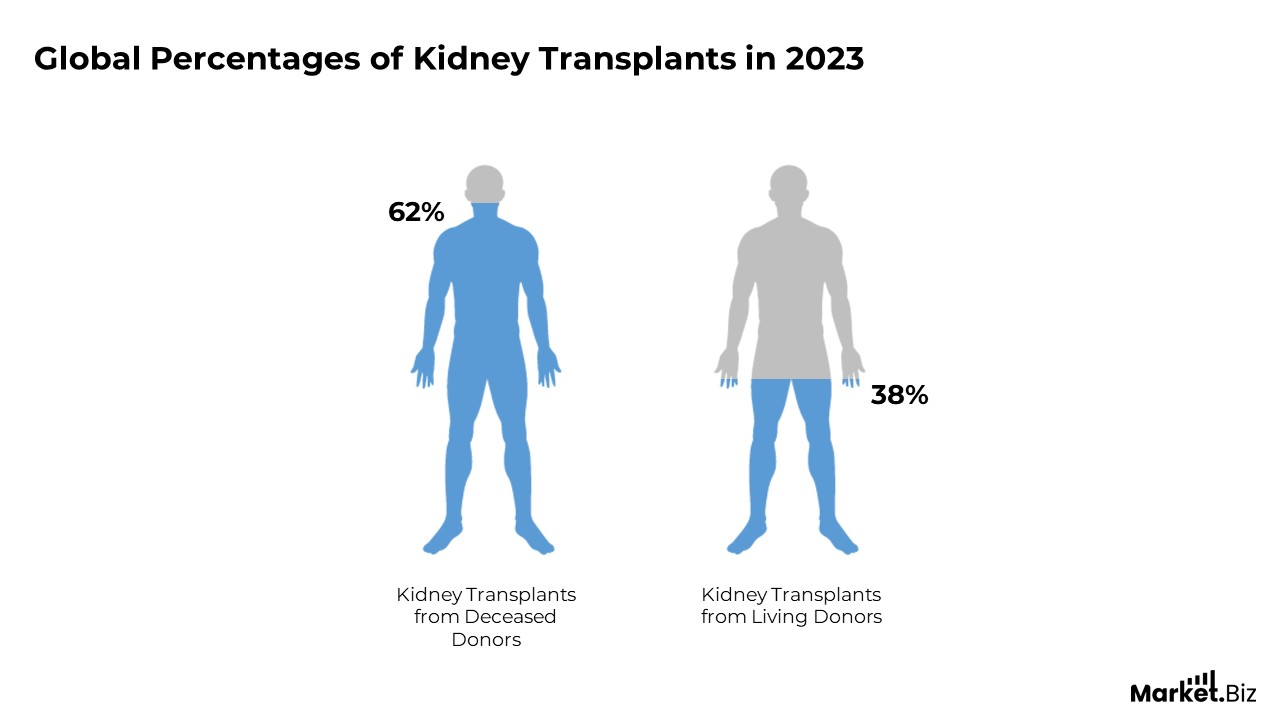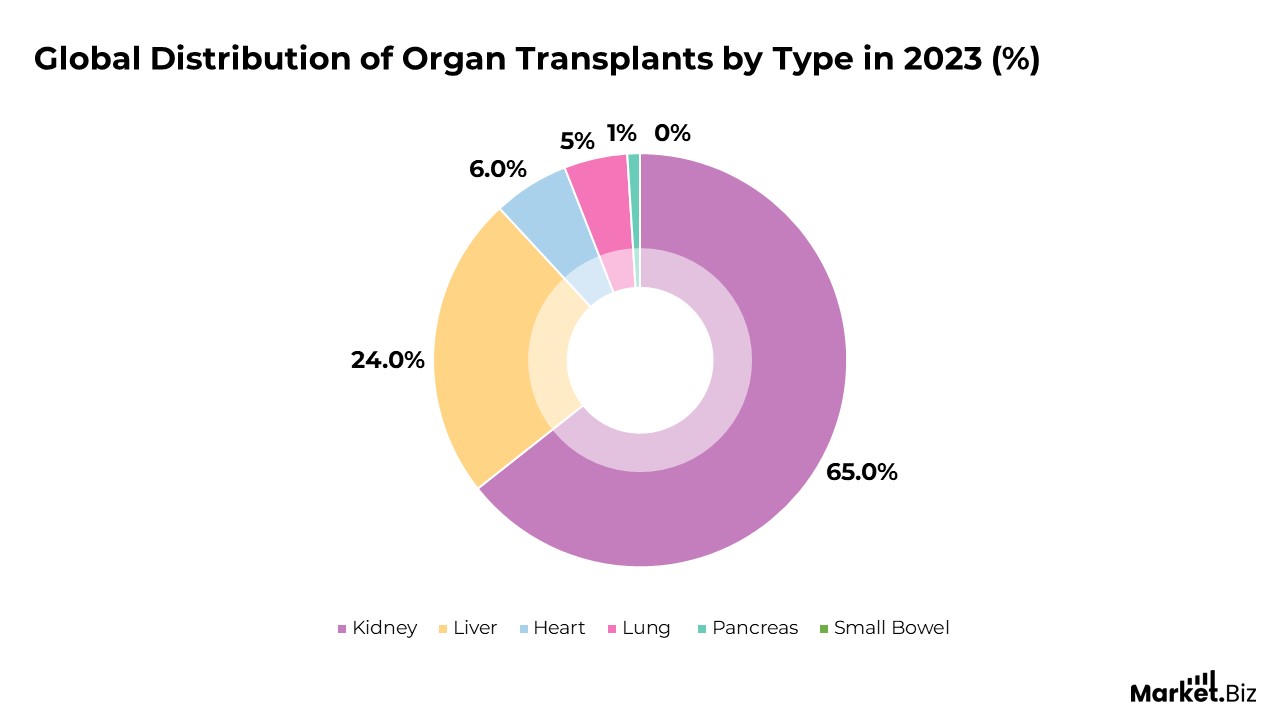Introduction
Organ Transplantation Statistics: Organ donation plays a crucial role in saving lives, providing people suffering from severe organ failure the opportunity to lead healthier, more fulfilling lives. Every year, millions of people around the world are waiting for organ transplants. Yet the gap between the growing demand and the limited supply of donor organs continues to expand. With ongoing advancements in transplant medicine, the need for donor organs has never been more urgent.
This section explores the current state of organ donation, highlighting key statistics that reveal the availability of organs, donor rates, and transplant success globally. These figures emphasize the significance of raising awareness and educating the public about organ donation to prevent lives from being lost due to a shortage of suitable organs.
Editor’s Choice
- The global demand for organ transplants continues to rise, with millions of people on waiting lists. The most sought-after organs are kidneys, livers, hearts, and lungs.
- Kidney transplants are the most frequently performed, making up many of the global transplant procedures, reflecting the critical need for kidney donations.
- Success rates for organ transplants are improving, with kidney transplants showing a one-year survival rate of 95%. While liver, heart, and lung transplants also continue to improve in both short-term and long-term survival outcomes.
- Advancements in organ preservation techniques, such as normothermic perfusion and cryopreservation, along with the use of AI and machine learning in organ matching, are leading to notable improvements in transplant efficiency and success rates.
- Various countries are introducing new policies to combat organ shortages and enhance fairness in transplantation. For instance, the U.K. has adopted an opt-out system for organ donation, and the US OPTN is working to improve organ allocation processes.
- Governments and organizations are making substantial investments to modernize the organ procurement system. In the U.S., the HRSA has proposed a $36 million increase to the 2024 budget to support advancements in organ transplantation.
Tissue and Organ Transplantation Market Size

- The global tissue and organ transplantation market is expected to expand from $21.3 billion in 2025 to $44.0 billion by 2033, with a compound annual growth rate (CAGR) of 9.5% from 2023 to 2032.
- The growth of the organ transplantation market is driven by rising demand, technological advancements in organ preservation and transplant procedures, and increasing public awareness of organ donation.
- In 2023, organ transplantation dominated the market, holding over 71.6% of the share due to the increasing prevalence of organ failure and advancements in transplant methods, expanding the donor pool.
- The tissue products segment captured more than 43.2% of the market in 2023, driven by the high use of tissues like skin, bone, and corneas in transplants, with skin grafts being a major demand driver.
- Hospitals led the tissue and organ transplantation market in 2023, holding over 38.7% of the market share, acting as key centers for transplant procedures.
- North America accounted for over 38.6% of the market in 2023, with a market value of $6.83 billion, driven by advanced healthcare infrastructure, cutting-edge technologies, and strong regulatory support.
(Source: Market.us)
History of Organ Transplantation
- The first successful human organ transplant with the kidney occurred in 1954.
- By the late 1960s, liver, pancreas, and heart transplants also became successful.
- Intestinal and lung transplants began in the 1980s.
- From the 1950s to the early 1970s, organ transplant hospitals and procurement governments have accomplished all organ transplantation and recovery aspects.
- There was no organization for locating compatible recipients outside of local hospitals, leading to many unused organs due to time constraints.
- In 1968, the Southeast Organ Procurement Foundation was established as a membership and scientific organization for transplant professionals.
- 1977, SEOPF introduced a computer-created organ matching system, the “United Network for Organ Division.”
- The advancements in rejection treatment and prevention in the early 1980s led to successful transplants and a growing organ demand.
- In 1982, SEOPF created the Kidney Center, the UNOS Organ Center, to provide constant assistance in organ placement.
- The National Organ Transplant Act (NOTA) was enacted in 1984 to create a national organ allocation and recovery framework, ensuring fair and efficient distribution based on medical criteria.
- In 1984, UNOS became an independent nonprofit organization, separating from SEOPF, and took over the Organ Procurement and Transplantation Network (OPTN) in 1986.
- The first dual-lung transplant was completed in 1986.
After 90’s
- In 1992, UNOS partnered with Donate Life America to raise public awareness and funding for organ donation.
- The first successful adult-to-adult living donor liver transplant occurred in 1998.
- The U.S. Department of Health and Human Services published the Final Rule for the process of the OPTN in 2000.
- By 2001, living organ donations outnumbered deceased donations for the first time.
- In 2014, vascularized composite allografts were included in federal organ regulations.
- In 2017, the number of extinct organ donors in the U.S. surpassed 10,000 for the first time.
- In 2022, the United States reached a historical milestone with its one-millionth transplant.
Other Key Milestones
- The first successful intestinal transplant was performed in 1987.
- The first split-liver transplant was carried out in 1988.
- The first successful living donor liver transplant was performed in 1989.
- The first successful living donor lung transplant took place in 1990.
(Source: United Network For Organ Sharing)
Global Organ Transplantation Statistics
Organ transplantation plays a vital role in saving lives around the world. In 2023, the field saw remarkable growth, driven by advancements in medical technology, healthcare practices, and donor programs. Here are some key global trends from 2023:
- In 2023, 172,409 organs were transplanted, reflecting a 9.5% increase from the previous year.
- The number of deceased organ donors reached 45,861 in 2023, significantly contributing to the availability of organs for transplant.
- On average, 18 transplants were conducted every hour in 2023, highlighting the efficiency and scale of the global organ transplant system.
- The kidney remains the most commonly transplanted organ globally, followed by the liver and heart.
- In 2023, 25% of organs transplanted came from Donation after Circulatory Death (DCD) donors.
- Living liver transplants accounted for 25% of all transplants performed worldwide in 2023.
- Living kidney transplants represented 39% of all transplants globally in 2023, reflecting a growing reliance on living donations for kidney procedures.

(Source: Global Observatory on Donation and Transplantation)
Organ Transplant Distribution Based on Donation Type
- Kidney transplants were the most prevalent, making up 65% of global transplants, indicating the substantial need for kidney donations.
- Liver transplants accounted for 24% of the global total, underscoring the critical need for liver donations worldwide.
- Heart transplants represented 6% of all transplants, highlighting the continued demand for heart transplants despite advancements in medical care.
- Lung transplants contributed 4%, illustrating their relatively less frequent but essential role in the transplant field.
- Pancreas transplants were less common, making up only 1% of the total number of global transplants.
- Small bowel transplants were the least frequent, comprising almost 0% of the total transplants, pointing to their rarity in organ transplantation.

(Source: Statista)
Waiting List for Transplants by Organ Type
In 2024, the global waiting list for transplants reflects a significant demand for various types of organs. The following is a breakdown of the number of patients awaiting transplants:
- The highest number of patients, 89,792, are on the waiting list for a kidney transplant.
- 9,424 individuals are awaiting a liver transplant, highlighting the persistent need for liver donations.
- 850 patients require a pancreas transplant, an essential procedure for those suffering from diabetes and related complications.
- 2,177 people are waiting for both a kidney and pancreas transplant, emphasizing the specialized need for these combined procedures.
- 3,456 patients are on the waiting list for a heart transplant, underscoring the continued demand for cardiovascular organ donations.
- 898 patients need a lung transplant, reflecting the critical need for this life-saving procedure for those with severe respiratory failure.
- Additionally, 240 patients are waiting for other transplants, which may involve less common procedures.
(Source: Health Resources & Services Administration)
Breakdown of Organ Transplants by Organ Type
In 2023, the global number of organ transplants varied by type, reflecting both the demand for and availability of donor organs.
- 27,332 kidney transplants were completed, indicating the high and consistent demand for kidney donations.
- 10,659 liver transplants were performed, highlighting the substantial need for liver donations.
- One hundred two pancreas transplants were conducted as a vital procedure for patients dealing with diabetes and related complications.
- 812 combined kidney and pancreas transplants were performed, demonstrating the specialized need for these dual organ procedures.
- Four thousand five hundred forty-five heart transplants were performed, reflecting the continuous demand for cardiovascular organ donations.
- Three thousand twenty-six lung transplants were completed, emphasizing the critical need for life-saving transplants for individuals with severe respiratory failure.
- One hundred fifty-three transplants were performed for other organ types, which may include less common procedures.
(Source: Health Resources & Services Administration)
Organ Waiting List Breakdown

Demographics of Organ Transplantation
Waiting List of Organ Transplantation -by Age
- People aged 50-64 years are the most likely to be waiting for organ transplants, with 44,529 people on the list.
- Following this, 26,694 individuals aged 65+ are waiting for organ transplants.
- Twenty-two thousand seven hundred eighty-six people aged 35-49 years are waiting for organ transplants.
- Eight thousand three hundred eighty-seven people aged 18-34 years are on the waiting list for organ transplants.
- A total of 887 people aged 11-17 years are waiting for organ transplants.
- Four hundred fifty-one children aged 6-10 years are awaiting organ transplants.
- Additionally, 634 children under the age of 5 are waiting for organ transplants.
Patients on the Waiting List for Organ Transplantation – By Ethnicity
- In 2023, White Hispanics are more likely to wait for organ transplantation at 40,476, followed by black Hispanics on the waiting list at about 28,552.
- About 23,757 Hispanics/Latinos are on the waiting list for organ transplantation.
- 5,673 Asian patients are on a waiting list for organ transplantation.
- About 901 American/Alaska Natives, 603 Pacific Islanders, and 937 Multiracial patients are on the waiting list for organ transplantation.
Organ Transplantation Success Rate
- Kidney transplants generally have a high success rate compared to other organ transplants. In the United States, the Organ Procurement and Transplantation Network (OPTN) reports a 95% one-year survival rate for kidney transplants from deceased donors, with an 85-90% five-year survival rate.
- The one-year survival rate for liver transplants from deceased donors is around 85-90%, while the five-year survival rate ranges from 70-75%.
- Heart transplants have a one-year survival rate of about 85-90%, with a five-year survival rate of 75-80%.
- The one-year survival rate for lung transplants is approximately 80-85%, while the five-year survival rate is around 50-55%.
- The success rates for combined kidney-pancreas transplants are similar to those of kidney transplants alone, with a one-year survival rate of about 95% and a five-year survival rate of 85-90%.
(Source: Organ Procurement and Transplantation Network (OPTN), National Institute of Health, Medanta The Medicity)
Organ Transplantation Statistics – By Region
- In 2023, the Americas recorded the highest number of kidney transplants globally, with approximately 43,090 transplants.
- Europe followed with 27,229 kidney transplants in 2023.
- The Western Pacific region performed 21,108 kidney transplants in 2023.
- Organ donations can come from deceased and living donors as long as blood and oxygen are maintained in the organs until recovery to ensure their viability.

Investments in Organ Donation Initiatives
Investments in organ donation have seen substantial growth, with various organizations working to enhance the system’s efficiency and reach.
- The Health Resources and Services Administration (HRSA) proposed a $36 million increase in the 2024 fiscal year budget, bringing the total allocation to $67 million for modernizing organ procurement and transplantation initiatives. This funding aims to improve IT systems, operational efficiency, and governance structures to achieve better overall outcomes.
- The Association of Organ Procurement Organizations reported that U.S. organ procurement organizations successfully transplanted 43,000 organs in 2023, continuing a steady growth trend over the last 13 years.
(Sources: Health Resources and Services Administration, UNOS, The Alliance)
Organ Donation Regulations Worldwide
Organ donation rules differ significantly across countries, focusing on ethical practices, donor agreement, and preventing organ trafficking.
- In the U.K., an opt-out organization, estimated consent, is implemented across Scotland, England, Wales, and Northern Ireland. This means individuals are presumed to be willing donors, except they openly opt-out. The aim is to boost the availability of organs for transplant while ensuring ethical standards are upheld.
- The UAE’s Federal Decree-Law No. 25 governs tissue and organ transplantation. It prohibits organ trafficking and requires the registration of donors through the national HAYAT registry, which is related to separate individual’s Emirates IDs.
- The World Health Organization advocates for stringent guidelines to confirm the ethical and safe obtaining of organs, calling for systems that stop trafficking and exploitation.
(Source: U.ae, WHO, National Institute of Health – Organ Donation)
Recent Developments
New Product Launches
- In August 2024, Mankind Pharma, a multinational pharmaceutical and healthcare company, launched the “Spreading Kindness” initiative to tackle the severe shortage of organ donors in India, where the donation rate is only 0.86 donors per million people.
- In June 2024, TransMedics launched the OCS Heart System, an advanced organ care system designed to preserve and monitor hearts outside the body for longer durations. This system is intended to improve heart transplant success rates by ensuring superior organ quality.
- In April 2024, NHSBT UK and the MOHAN Foundation launched the DCD (Donation after Circulatory or Cardiac Death) app at the Commonwealth Tribute to Life conference to address the ongoing organ shortage.
Acquisitions
- In August 2024, Getinge, a medical technology company, acquired Paragonix Technologies, Inc., a provider of organ transport products and services. This acquisition expands Getinge’s portfolio into high-growth markets that complement its existing acute heart and lung support offerings in transplantation, positioning the company at the forefront of the rapidly expanding organ preservation and transportation sector.
- In July 2023, CareDx, Inc., a precision medicine company, acquired MediGO, Inc. to enhance its digital health portfolio and support the organ procurement organization (OPO) market. This acquisition also strengthened CareDx’s pre-transplant services, aiming to reduce transplant wait times and improve access to donated organs.
Technological Advancements
- New preservation methods, including normothermic perfusion and cryopreservation, are being developed to better maintain organs during transport and storage, which helps improve transplant success rates.
- AI and machine learning advancements are being utilized to enhance organ matching algorithms, improving the accuracy and speed of matching donors with recipients and potentially reducing transplant wait times.
Regulatory Landscape
- In early 2024, the European Union updated its organ donation directives to enhance the safety and quality of organs intended for transplantation while encouraging cross-border organ exchanges to optimize allocation.
- In 2023, the U.S. Organ Procurement and Transplantation Network (OPTN) introduced new policies to improve organ allocation, increase transparency, and ensure fair access to transplants for all patients on the waiting list.
Research and Development
- Researchers are investigating the potential of bioprinting and regenerative medicine to develop lab-grown organs, which could eliminate the need for human organ donors and transform the transplantation field.
- Research into xenotransplantation the transplantation of organs from animals, especially pigs, to humans—is underway. This effort aims to address the organ shortage crisis by offering an alternative source of organs.
Funding Rounds
- In September 2024, eGenesis announced the completion of a $191 million Series D financing round. The funds were used to improve the company’s lead product candidate, EGEN-2784, into a first-in-human study for kidney transplantation. The financing also supported the progress of pipeline programs and production scaling.
- In 2024, Omnicyte, a company focused on regenerative medicine and organ preservation, raised $50 million to develop innovative technologies designed to extend the viability of donated organs and enhance transplant success rates.
Conclusion
Organ Transplantation Statistics: Organ transplantation remains an essential medical procedure that saves countless lives worldwide. The statistics highlight a substantial demand for various organ transplants, with kidney donations being the most urgently needed.
While advancements in medical technology and donor programs have led to improved outcomes and an increase in the number of transplants performed. Waiting lists continue to grow, especially among individuals aged 50 and older.
Additionally, the data emphasizes the specialized need for combined organ transplants, such as kidney and pancreas procedures, as well as the ongoing demand for heart, lung, and liver transplants.
Despite these advancements, the gap between the number of available donors and those waiting for transplants emphasizes the urgent need for increased awareness, improved donor programs, and more effective medical strategies to meet the rising demand for organ transplants.
Strengthening efforts to encourage donor registration and educating the public on the importance of organ donation will be critical in addressing the global shortage and enhancing the success rates of transplants across all organ types.
FAQ’s
The global demand for organ transplants continues to rise, with millions of people awaiting various organ transplants. The most sought-after organs are kidneys, livers, hearts, and lungs. The length of waiting lists remains challenging due to the limited availability of compatible donors.
In 2023, kidney transplants comprised the largest proportion of transplants performed, followed by liver and heart transplants. Lung and pancreas transplants also represent significant numbers in the total global transplant count.
As of September 2024, more than 89,792 people are on the waiting list for kidney transplants, while other organs, such as the liver, heart, and lungs, also have substantial waiting lists. The number of patients in need of transplants continues to rise each year, underscoring the urgent need for more organ donors.
The age group most commonly represented on the organ transplant waiting list is 50-64 years, with a large number of individuals in the 65+ age group also in need of transplants. However, people of all ages, including children, are waiting for organ transplants, with the highest concentration found in the 50-64 age range.
Living organ donors have had a significant impact, particularly in kidney transplants, where living donations account for many procedures. These donations help shorten patient waiting times and ease the strain on deceased donor programs, allowing more efficient use of available organs.
